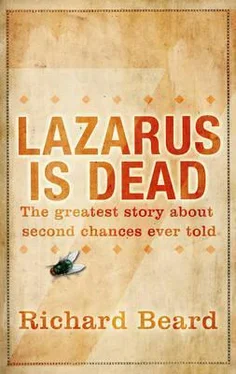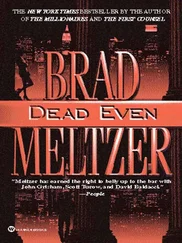When they can do no more, the sisters lift the body between them. Lazarus is almost weightless, hollowed out by disease. They carry him down to the lower tomb; fetch lamps, surround their brother with light. Their fingers touch. They leave while the flames are bright.
Outside, in the flat shock of daylight, they turn and shield their eyes for the end. Absalom and Faruq seal the tomb, rolling a huge fitted rock across the entrance.
Lazarus is buried.
1
HE COULD BE trapped inside his body. In the search for Lazarus there are those who follow him into the earth, attentive for signs of life.
For Norman Mailer in The Gospel According to the Son (1997), death is a place where maggots speak: ‘ “Oh Yeshua,” said Lazarus, “small creatures speak to me, and they say, ‘You are not our master, Lazarus, but our wiping-cloth.’ Thus speak the maggots.” ’
The authors of the medieval Mystery plays seize on this same information. They too have Lazarus buried alive, and he is eloquent about his ordeal when he returns: ‘Wormes shall in you brede / As bees do in the byke, / And ees out of youre hede / Thusgate shall paddokys pyke.’
Martha catches a sob in her throat, grabs her skirts and hurries back to the house. Something of Lazarus the man will always remain with the body.
At the house she throws the blanket and the new straw mat outside, and burns them both. She puts the rugs and low brass tables back into position, but then can’t leave the room without making tiny adjustments. The tables aren’t quite right; nor are the rugs. She can never get the room precisely as she wants it.
That night she sleeps a little in the darkest hours, but is woken for the third morning in a row by wailers who aren’t that good at wailing. Not enough feeling. Not even close.
Mary does what she can. She boils water and makes dough for bread, but forgets she has to cover it. Their father is dead and their mother is dead and now both their brothers are dead. Experience counts for nothing — her heart is unhardened to grief.
The sisters spend the day after the burial blaming themselves.
Mary should have prayed harder, believed more sincerely.
Martha should have called for the healer as soon as Lazarus fell ill. They should have tried Bethesda while he could still reach the water.
During the third night, in the silence, Martha accepts that she’ll have to cope. Her desolation is complete.
In the morning, Mary is beside herself with excitement. ‘Martha, wake up! Jesus is coming! They say he’s on the road. He’s almost here in Bethany.’
Martha dresses quickly. She ties her apron and runs to the gate, her hands clenched into fists by her sides. ‘If you had been here, my brother would not have died’ (John 11: 21). Mary comes out of the house. She runs and falls down. ‘Lord, if you had been here, my brother would not have died’ (John 11: 32).
Lazarus is dead and this is the truth in Bethany: Jesus has forsaken his friend.
1
‘ JESUS WEPT .
Then the Jews said, “See how he loved him! ” ’ (John 11: 35–6).
Jesus is weeping when he finds the tomb, weeps at the stone across the entrance.
‘ Take away the stone ’ (John 11: 39).
Which is when Martha, out of confusion or spite, mentions the smell: ‘ by this time there is a bad odour, for he has been there four days ’. She knows this is nonsense — she prepared the body herself — but she can’t allow Jesus to go unchallenged. He has arrived too late, and there is nothing he can usefully do.
Jesus wept .
Is that all?
Martha wants more, and in this episode the Gospel of John has lost shape in the move between languages. Translation scrapes off an edge of intensity, until modern English texts have Jesus ‘ deeply moved in spirit and troubled ’ (John 11: 33, New International Version).
In the Greek original he is embrimomenos , he is angry . He weeps, yes, but Martha is right: weeping is not enough. He is utterly furious:
All the blood went to his [Jesus’s] head, his eyes rolled and disappeared, only the whites remained. He brought forth such a bellow you’d have thought there was a bull inside him, and we all got scared. Then suddenly while he stood there, trembling all over, he uttered a wild cry, a strange cry, something from another world. The archangels must shout in the same way when they’re angry …‘Lazarus!’ he cried. ‘Come out!’
(Nikos Kazantzakis, The Last Temptation , p. 427)
The Greek tradition, as represented by the novelist Kazantzakis, preserves the emotional truth of the scene. Jesus had learned this tearful anger many years earlier from Lazarus, on the shore of the lake in Galilee. Lazarus, too, had been enraged by the harshness of the hand of god.
At the tomb of Lazarus, Jesus weeps for his friend as his friend had wept for his brother Amos, with anger as well as pity. Jesus weeps for then and for now, for himself and for Lazarus, and for the worst which is yet to come.
2
Most of the surviving evidence about Lazarus originates in this instant. The paintings and etchings, poems and plays, sculptures, operas and symphonies all unfailingly centre on the raising of Lazarus from his tomb. Unfortunately, these varied testimonies lack consistency in the detail.
The squabbling starts with his physical condition.
The stone slides back and Lazarus emerges into the light. His linen grave clothes are stained with aloe juice, and fluids the body releases in death. He can barely move. He falls flat on his bandaged face.
Martha and Mary rush to unwrap him, their hands trembling against joints and muscles miraculously warm and intact. They roll him over to see his face, and Lazarus stares at the sun, his mouth unbound and agape.
Descriptions of his decomposed body are simply wrong — Lazarus as a skeleton, with a green head, or his body riddled with worms, he ‘stynke as dog in dyke’. Before his death, yes — afterwards, no. Lazarus does not return half dead in an advanced state of decay, a golem in the shadow of Jesus.
If he did, the bible might have said so.
The other extreme is equally unlikely. In An Epistle (1888), Robert Browning reports that Lazarus was ‘As much, indeed, beyond the common health / As he were made and put aside to show’. Yet Lazarus cannot come back as an impeccable human specimen. He is a man like any other, at least as far as this is possible for someone who has suffered, died, been entombed for four days, and now finds himself blinded by the Bethany sunshine.
Nevertheless, the covered noses need explaining. In many of the surviving records there are witnesses to the raised Lazarus who immediately hold their noses. He doesn’t smell — Martha has made sure of that. The covered nose is therefore less a reaction to an odour, more to a resurrection. This action, faithfully noted across the centuries, is a judgement.
Look again at that painting by the three Limbourg brothers from the fifteenth century, a contribution to the Très Riches Heures entitled The Raising of Lazarus . One of the onlookers pulls his tunic across his nose while holding out his other hand palm forward. He is resisting the evidence that Lazarus is back from the dead. When bystanders cover their noses, they’re saying that Lazarus is not true. He should smell like the dead. He cannot be believed.
There is another consistent oddity in these illustrations. In the Limbourg image, the two men nearest to Lazarus bow down before him. From Rembrandt through Julius Schnorr von Carolsfeld to Gustave Doré, there are immediate eye witnesses who prostrate themselves at the sight of Lazarus raised.
Читать дальше












